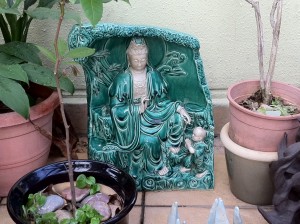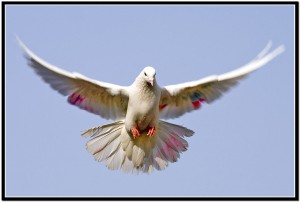 Later this year I will be beginning a series of classes with meditations upon the “Tree of Yoga” as a focus point, so in my articles over the next few weeks I will be focusing upon themes relating to this. In this article I explain some basic working definitions of yoga from a meditative perspective, and how we can begin working with these ideas in a practical fashion.
Later this year I will be beginning a series of classes with meditations upon the “Tree of Yoga” as a focus point, so in my articles over the next few weeks I will be focusing upon themes relating to this. In this article I explain some basic working definitions of yoga from a meditative perspective, and how we can begin working with these ideas in a practical fashion.
Three Levels of the Meaning of Yoga That can be Distinguished
One of the main meanings of the Sanskrit word ‘Yoga’ is ‘Union’. From this we can see that the many different practices of yoga aim fundamentally at achieving a state of union.We can distinguish three types or stages of union in the path of yoga:
- Accomplishing the union of the mind and body
- Accomplishing the union of the body-mind with the environment
- Accomplishing the union of the self with the Cosmos
So, here we can see the three basic stages; the first stage focuses on unifying or synchronizing the body and mind into a singular, harmonized unit. The second stage focuses on expanding our self sense beyond the body mind so that our self-sense includes greater aspects of our internal and external environment. The third stage involves releasing all boundaries between our personal sense of self and the Cosmos, thus achieving the ultimate union of self and cosmos into the primal or Universal Self. This final stage, the recognition, embodiment and articulation of the Universal or True Self is really the endgame of all yoga’s whether you are talking about hatha yoga, bhakti yoga, raja yoga or any of the other forms of yoga. For the remainder of the article we will be focusing on the first level of union in the path of yoga.
A Closer Look at Stage 1: The Two Stages of Unifying the Body-Mind
Oftentimes the start of many peoples IDEA of the spiritual path involves an attempt to “go beyond the limitations of and attachments to the body and its appetites”. The body is seen as the obstacle to inner growth, continually getting in the way of our spiritual aspirations, and “detachment” from the body is where a lot of people place their efforts.
However, in reality, and this is a really key understanding, most people are already detached from the body in the sense of being mentally disconnected to it! So, the first goal for almost 100% of us is to reconnect our mind to our body as they exist in the present moment, here and now.
How did we disconnect from the body in the first place?
Our body-mind disconnection takes place in two stages:
- The separation of the ego from the body.
As we grow up our self-sense develops in stages. As young children we identify with our body, as teenagers we identify with our emotions. By the time we get to young adulthood almost all of us identify ‘self’ as being our mind, and the relationship to our ‘self’ to the body is like a rider to a horse; the mind or ego is like the rider, and the body is like the horse. Thus our mind and body have now become experientially separate; ‘I’, or my ego possesses my body which is a separate object. This is the first separation or disconnect of mind from body
- Stage 2: The Mind/Ego Divides Against Itself – The Separation of Persona from Shadow
So, our ego is now separated from our body, unfortunately it gets worse. Having now identified our ‘self’ as our ego, our ego then splits into what in psychological terms is called the ‘persona’ and the ‘shadow’.
What are the Persona and Shadow?
The Persona– The persona is that part of the contents of our mind and ego that is acceptable to our self-image. The persona is the conscious perception of who we think we are, that part of the contents of our consciousness that we allow ourself to see.
The Shadow – The shadow is the parts of our mind and ego that is not acceptable to our self image. The shadow is all the parts of our mind and ego that we refuse to consciously acknowledge and so as a result gets repressed or ‘pushed down’ into our unconscious mind. You can find more on the shadow self in my previous article on the shadow: Six Tips for Releasing the shadow Self. Another word for the shadow would be the repressed unconscious.
Bringing this all together
So, from this we can see that in order to re-unify our body-mind into a synchronized whole we need to go through two stages:
- Unify our mind by healing the divide between our persona and shadow, thus creating a healthy functional ego.
- Unify our body and ego by bringing our awareness and attention back into the body and the present moment.
There are a lot of practices that are specifically designed to help facilitate these two stages. For example traditional psychotherapy (eg: Freudian and Transactional Analysis) aim at creating a healthy ego through unifying the shadow and persona. Hatha yoga, Qi gong and Tai-Qi are all helpful methods for the second stage of unifying the mind-body. There are also psychological therapies that aim at unifying the body-mind such as gestalt therapy and aspects of the humanistic psychology approach of Carl Rogers.
The Centaur
The Centaur is a mythic beast that is half human and half horse. Centaur or centauric is sometimes used as a name for the state of consciousness where the body-mind are unified. The centaur is not a human riding a horse, the centaur is both the human and the horse as a single entity, no division.
The centauric state of consciousness is a state of being where our body intelligence and mental intelligence are always working in harmony. When we accomplish this union our body-mind union becomes more than the sum of its parts, we start to be capable of achieving things that ordinary people would consider ‘impossible’ or ‘beyond them’. Much of the Human Potential Movement is aimed at accomplishing the centauric state, the unity of the body-mind.
The centauric state of a unified body-mind acts as the stable basis upon which we can then go onto explore higher and more expanded levels of consciousness and being. If we try and ‘expand’ our consciousness too extensively and quickly before stabilizing our centaur we will quite rapidly find ourself struggling with the unhealed elements of our ego, persona and shadow.
Awareness Practices to Start Unifying the Body-Mind: Meditating on the Body as a “Consciousness Sponge”.
So, I’ve covered quite a lot of ground above, and what I want to do is finish with a really simple two stage practice to help you begin integrating your body-mind. It can be done as a short 1-5minute practice, but just as appropriately and easily it can be done as a 15-30 minute form.
Stage 1: Noticing Resistance.
Simply sit quietly and notice the resistance that your mind has to entering fully into the present moment and into your body. Notice how it is always jumping away from present moment awareness of the body, diving into the past and forward to the future. Take your observation of this resistance as your object of awareness for the first part of the meditation. Don’t try and overcome it, just notice it.
Stage 2: Your body as a Sponge
In the second stage imagine that your physical body is like a dry sponge and your mind and consciousness is like water. Feel all the thoughts and feelings in your mind being gradually absorbed into your body as it sits in the present moment, just like water being absorbed by a dry sponge. Feel your mind fully inside the skin of your body, fully present in the here and now, in communion with your body. For the remainder of the meditation explore this feeling of a unified body-mind as deeply and fully as you can, rest your awareness on it and in it as fully as possible.
© Toby Ouvry 2011, you are welcome to use or share this article, but please cite Toby as the source and include reference to his website www.tobyouvry.com







